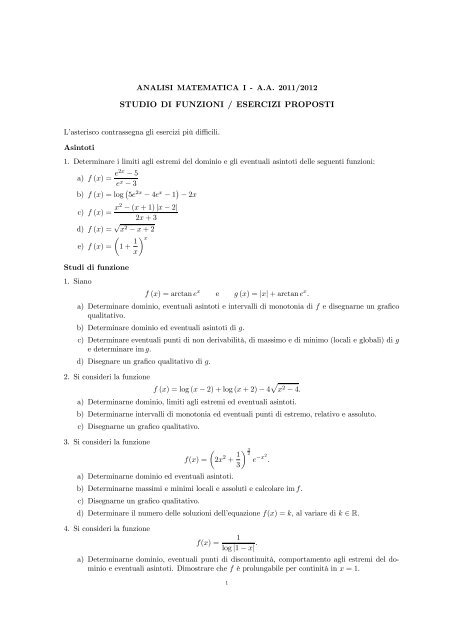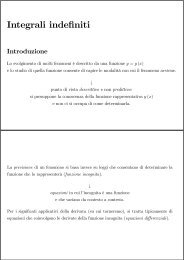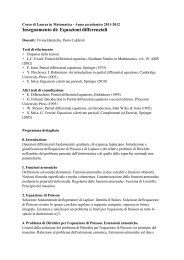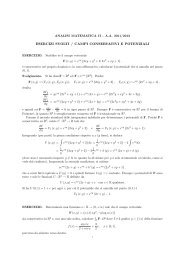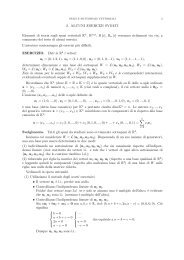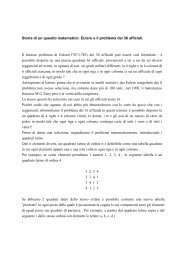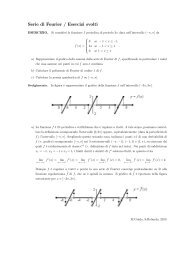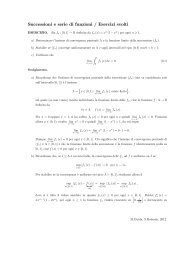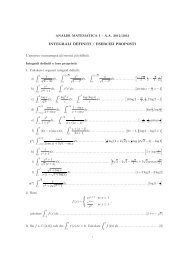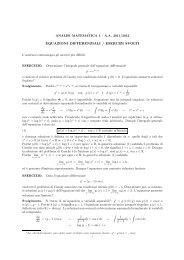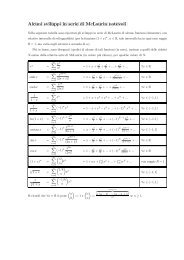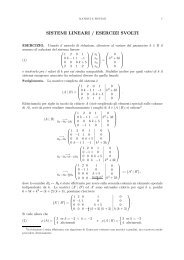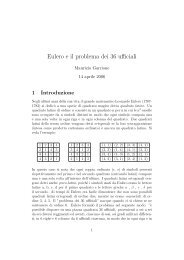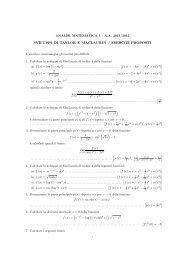studio di funzioni / esercizi proposti - Corso di Studi in Matematica
studio di funzioni / esercizi proposti - Corso di Studi in Matematica
studio di funzioni / esercizi proposti - Corso di Studi in Matematica
You also want an ePaper? Increase the reach of your titles
YUMPU automatically turns print PDFs into web optimized ePapers that Google loves.
ANALISI MATEMATICA I - A.A. 2011/2012<br />
STUDIO DI FUNZIONI / ESERCIZI PROPOSTI<br />
L’asterisco contrassegna gli <strong>esercizi</strong> più <strong>di</strong>fficili.<br />
As<strong>in</strong>toti<br />
1. Determ<strong>in</strong>are i limiti agli estremi del dom<strong>in</strong>io e gli eventuali as<strong>in</strong>toti delle seguenti <strong>funzioni</strong>:<br />
a) f (x) = e2x − 5<br />
e x − 3<br />
b) f (x) =log 5e 2x − 4e x − 1 − 2x<br />
c) f (x) = x2 − (x +1)|x − 2|<br />
2x +3<br />
d) f (x) = √ x 2 − x +2<br />
<br />
e) f (x) = 1+ 1 x<br />
x<br />
Stu<strong>di</strong> <strong>di</strong> funzione<br />
1. Siano<br />
f (x) = arctan e x e g (x) =|x| +arctane x .<br />
a) Determ<strong>in</strong>are dom<strong>in</strong>io, eventuali as<strong>in</strong>toti e <strong>in</strong>tervalli <strong>di</strong> monotonia <strong>di</strong> f e<strong>di</strong>segnarneungrafico<br />
qualitativo.<br />
b) Determ<strong>in</strong>are dom<strong>in</strong>io ed eventuali as<strong>in</strong>toti <strong>di</strong> g.<br />
c) Determ<strong>in</strong>are eventuali punti <strong>di</strong> non derivabilità, <strong>di</strong> massimo e <strong>di</strong> m<strong>in</strong>imo (locali e globali) <strong>di</strong> g<br />
e determ<strong>in</strong>are im g.<br />
d) Disegnare un grafico qualitativo <strong>di</strong> g.<br />
2. Si consideri la funzione<br />
f (x) =log(x − 2) + log (x +2)− 4 x 2 − 4.<br />
a) Determ<strong>in</strong>arne dom<strong>in</strong>io, limiti agli estremi ed eventuali as<strong>in</strong>toti.<br />
b) Determ<strong>in</strong>arne <strong>in</strong>tervalli <strong>di</strong> monotonia ed eventuali punti <strong>di</strong> estremo, relativo e assoluto.<br />
c) Disegnarne un grafico qualitativo.<br />
3. Si consideri la funzione<br />
f(x) =<br />
<br />
2x 2 + 1 3<br />
2<br />
e<br />
−x 2 .<br />
3<br />
a) Determ<strong>in</strong>arne dom<strong>in</strong>io ed eventuali as<strong>in</strong>toti.<br />
b) Determ<strong>in</strong>arne massimi e m<strong>in</strong>imi locali e assoluti e calcolare im f.<br />
c) Disegnarne un grafico qualitativo.<br />
d) Determ<strong>in</strong>are il numero delle soluzioni dell’equazione f(x) =k, alvariare<strong>di</strong>k ∈ R.<br />
4. Si consideri la funzione<br />
1<br />
f(x) =<br />
log |1 − x| .<br />
a) Determ<strong>in</strong>arne dom<strong>in</strong>io, eventuali punti <strong>di</strong> <strong>di</strong>scont<strong>in</strong>uità, comportamento agli estremi del dom<strong>in</strong>io<br />
e eventuali as<strong>in</strong>toti. Dimostrare che f è prolungabile per cont<strong>in</strong>ità <strong>in</strong> x =1.<br />
1
2 M.GUIDA, S.ROLANDO<br />
b) Determ<strong>in</strong>are massimi e m<strong>in</strong>imi locali e assoluti <strong>di</strong> f. Detto˜f il prolungamento per cont<strong>in</strong>uità<br />
<strong>di</strong> f, determ<strong>in</strong>are massimi e m<strong>in</strong>imi locali e assoluti <strong>di</strong> ˜f.<br />
c) Disegnare un grafico qualitativo <strong>di</strong> f.<br />
5. Si consideri la funzione<br />
f(x) =<br />
e−x<br />
5 |x| − 2 .<br />
a) Determ<strong>in</strong>arne dom<strong>in</strong>io ed eventuali as<strong>in</strong>toti.<br />
b) Stu<strong>di</strong>arne il segno.<br />
c) Determ<strong>in</strong>arne gli eventuali punti <strong>di</strong> non derivabilità e trovarne tutti i punti <strong>di</strong> massimo e <strong>di</strong><br />
m<strong>in</strong>imo relativo, <strong>in</strong><strong>di</strong>cando gli <strong>in</strong>tervalli <strong>di</strong> monotonia della funzione.<br />
d) Disegnarne un grafico qualitativo.<br />
6. Si consideri la funzione<br />
f(x) =1+<br />
ex<br />
x − 2 .<br />
a) Verificare graficamente che f si annulla <strong>in</strong> un solo punto α ∈ (0, 1).<br />
b) Disegnare un grafico qualitativo della funzione f.<br />
c) Disegnare un grafico qualitativo della funzione g(x) =logf(x).<br />
7. Per le seguenti <strong>funzioni</strong>, determ<strong>in</strong>are dom<strong>in</strong>io, eventuali simmetrie e as<strong>in</strong>toti, eventuali punti <strong>di</strong><br />
<strong>di</strong>scont<strong>in</strong>uità e <strong>di</strong> non derivabilità, <strong>in</strong>tervalli <strong>di</strong> monotonia, estremi locali e globali, tracciandone poi<br />
un grafico qualitativo:<br />
a) f (x) =<br />
e x − 1 <br />
2 − e x<br />
b) f (x) = 3x 1<br />
1 − 2x e− x 2<br />
<br />
1<br />
c) f (x) = arctan<br />
x − 2 − log |x − 2|<br />
8. Stu<strong>di</strong>are le seguenti <strong>funzioni</strong>, determ<strong>in</strong>andone anche <strong>in</strong>tervalli <strong>di</strong> concavità e convessità ed eventuali<br />
punti <strong>di</strong> flesso:<br />
a) f (x) = x2<br />
+log|x +1|<br />
2<br />
b) f (x) =log|x| + |x| + x 3<br />
c) f (x) =x +log x 2 +1 <br />
s<strong>in</strong> (2x)<br />
d) f (x) =cosx −<br />
2<br />
9. Sfruttandone le simmetrie, stu<strong>di</strong>are le seguenti <strong>funzioni</strong>:<br />
|x| − x2<br />
a) f (x) =<br />
x 2 − 9<br />
b) f (x) =xe 1<br />
log|x|<br />
c) f (x) =|x +1| e − 1<br />
(x+1) 2
STUDIO DI FUNZIONI 3<br />
ALTRE SOLUZIONI.<br />
Non sono riportati i risultati che si possono facilmente controllare tramite il sito www.wolframalpha.com,<br />
o che sono impliciti nelle richieste del testo.<br />
1. a) lim f (x) = 5<br />
x→−∞ 3 , lim f (x) =±∞, lim<br />
x→(log 3) ±<br />
x =log3as<strong>in</strong>toto verticale completo.<br />
b) lim f (x) = −∞, lim<br />
x→0 +<br />
orizzontale destro.<br />
x→+∞ f (x) =+∞; y = 5 3<br />
as<strong>in</strong>toto orizzontale s<strong>in</strong>istro,<br />
f (x) = log5; x = 0 as<strong>in</strong>toto verticale destro, y = log5 as<strong>in</strong>toto<br />
x→+∞<br />
c) lim f (x) =+∞, lim f (x) =±∞, lim f (x) = 1<br />
x→−∞ x→(−3/2) ± x→+∞ 2<br />
; y = x − 2 as<strong>in</strong>toto obliquo s<strong>in</strong>istro,<br />
x = − 3 2 as<strong>in</strong>toto verticale completo, y = 1 2<br />
as<strong>in</strong>toto orizzontale destro.<br />
d) lim f (x) =+∞; y = −x + 1<br />
x→±∞ 2 as<strong>in</strong>toto obliquo s<strong>in</strong>istro, y = x − 1 2<br />
as<strong>in</strong>toto obliquo destro.<br />
e) lim f (x) =e, lim f (x) =+∞, lim<br />
x→±∞ x→(−1) −<br />
x = −1 as<strong>in</strong>toto verticale s<strong>in</strong>istro.<br />
f (x) =1; y = e as<strong>in</strong>toto orizzontale completo,<br />
x→0 +


